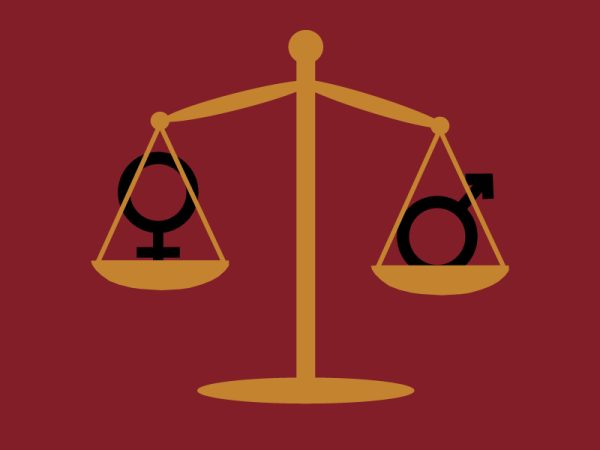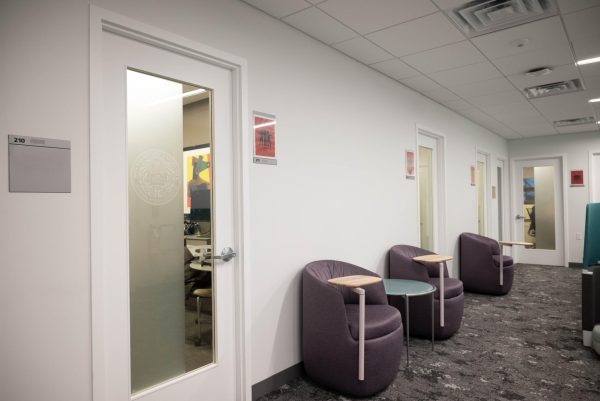Women in STEM at Northeastern persevere through male-dominated classes
To address the gender disparity in STEM courses, Northeastern has created programs such as the Women in Engineering program, or WIE.
March 18, 2021
Despite the rapid growth of students in science, technology, engineering and mathematics, or STEM, disciplines across universities nationwide, the percentage of female students in these majors has only grown 1% since 2015 — from 25% to 26%.
To address this disparity, Northeastern has created several programs focused on diversity and inclusion, such as the Women in Engineering Program, or WIE. In hopes of increasing the percentage of women in STEM, WIE offers resources to female engineering students to promote success.
Despite the university’s efforts, female STEM majors at Northeastern still find themselves in classes filled with male students.
Erica Moore, a first-year bioengineering major, estimated that female students only made up about one-fourth to one-third of each of her STEM-focused classes. Although Moore said she feels lucky to not have experienced any explicit verbal discrimination or sexism, she recalls her male classmates taking charge more than the females in group projects.
“Girls have to work harder to have a leadership position or make their voices heard,” Moore said.
Moore was sure she wanted to major in humanities until she changed her mind at the end of her junior year of high school. Although she liked science, it was a big change for her to adjust from humanities-focused classes to STEM-focused classes. She said that her desire for more female representation in STEM has inspired her to persevere in the field.
“I know the culture around being in engineering is that it’s very hard to succeed as a woman,” Moore said. “If I succeed in this career and [become] a woman in STEM, that would be [more] representation for younger girls in the future.”
Sreya Katabathuni, a second-year computer science and business administration combined major, agrees with the need for representation of women in STEM. Originally going into college as a business major, Katabathuni said she experienced imposter syndrome when she added the male-dominated computer science major in the summer before her second year.
“I think there might be this notion that because I’m not doing full [computer science], I’m not as competent as people who are doing the straight [computer science] major,” Katabathuni said.
Along with female representation in STEM, Katabathuni also emphasizes the need for more representation of people of color in STEM. She recognizes that there is a low growth rate for people of color to progress further into high tech roles, thus building a sense of suppression in the “Caucasian-focused” field.
In 2015, the National Center for Education Statistics reported low percentages of women of color receiving STEM degrees from higher education institutions. Only 5% of Asian women, 3.8% of Latinas and 2.9% of Black women received these degrees. Other studies found that 45% of women in STEM leave their jobs after feeling both underpaid and underrepresented.
Although it is challenging to be a woman in STEM, some students say that the classes are rewarding. Kelly Choate, a first-year computer engineering major, finds the course load to be heavy but interesting.
“I genuinely enjoy engineering,” Choate said. “When I go ‘what homework do I want to do first,’ I usually go to the math and sciences.”
Many attribute quality professors to their love for STEM classes. Moore admires Professor Otonye Braide-Moncoeur, her chemistry professor for the fall semester. Working with young girls, Professor Braide is able to offer more female representation in STEM, Moore said.
Even though the classes and professors at Northeastern inspire female STEM majors to keep going, there is still a disproportionate amount of male and female students in STEM. Tasmiha Amir, a first-year computer engineering and computer science combined major, thinks this is because the stereotype of a male-dominated field drives females away from pursuing a career in STEM.
“I think many young women are discouraged by what they hear about it and going into a major knowing it’s almost all men is not the most inviting feeling,” Amir said.
Despite the hesitation of female students joining STEM majors, Katabathuni expressed hope for a more diverse future in STEM.
“For me, I had no experience in CS and I didn’t think I would like STEM but I ended up persevering,” Katabathuni said. “At the end of the day, it never hurts to try. Finding something new [and] seeing if you like it is the best way to determine if it’s what you want to do in life.”


















